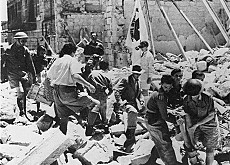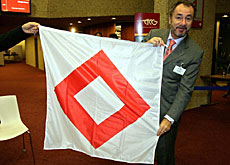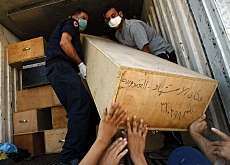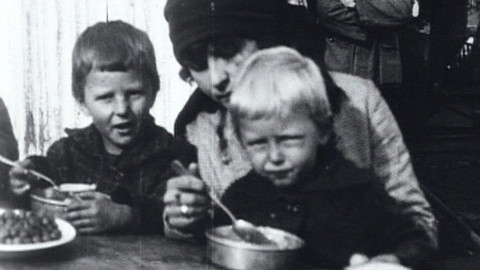How the Red Cross once skated on thin ice

Almost morally and financially bankrupt after the Second World War, the International Committee of the Red Cross (ICRC) flirted with extinction, says a new book.
“From Yalta to Dien Bien Phu” charts how the Swiss-run organisation came back from the brink, aided by the advent of the Cold War and the outbreak of new conflicts around the world.
The book covers the decade from 1945-55.
“It was a very difficult period for the ICRC because at the end of the Second World War – even though it had done a considerable amount work – it came in for heavy criticism,” author Catherine Rey-Schyrr told swissinfo.
“As soon as the truth about the concentration camps emerged, the ICRC was condemned for not having done enough for the detainees, for not having denounced the extermination of the Jews nor the inhumane treatment of Soviet prisoners.”
The ICRC also came under sustained attack for its close links to Switzerland – something that surprised Rey-Schyrr, who worked for the organisation for more than 30 years.
At the end of the war, the Swiss were criticised by the Allies for doing business with the Third Reich and the Geneva-based ICRC was tarred with the same brush.
“The most virulent criticism came from the USSR and eastern European countries which had suffered the most and where the ICRC had been most restricted in its efforts to help prisoners of war and the population,” said the author, who spent six years researching the 750-page book.
“But it also came from the national Red Cross societies, mainly the US and Sweden, which wanted to internationalise the ICRC.”
Isolation
Virtually friendless, the organisation was also running on empty. During the war, the ICRC had survived on funding from the Swiss government and the Red Cross societies whose nationals it was aiding.
But funds dried up with the cessation of hostilities when most of the ICRC’s activities were channelled towards looking after German prisoners of war.
“Immediately after the war the future of the ICRC was seriously in the balance, both financially and because countries wanted to either internationalise or even shut it down,” added Rey-Schyrr.
But from 1947 onwards, the emergence of conflicts linked to decolonisation, plus the onset of the Cold War, enabled the ICRC to claw its way off the ropes.
Its first big post-war intervention came in Palestine in 1948 where, according to the Rey-Schyrr, the ICRC performed in “remarkable and exemplary fashion”.
“[The conflict] gave renewed visibility and credibility to the ICRC and once again showed the need for a neutral intermediary.”
The ensuing years also saw the ICRC intervene in Indonesia, Vietnam, Kashmir and Korea, where delegates recounted napalm being used for the very first time.
The book reveals how the ICRC was able to do a great deal for the hundreds of thousands of prisoners of war in South Korea but very little for the population, which suffered terribly.
“Red Menace”
With the West closing ranks in the face of the “Red Menace”, outright hostility towards the ICRC also shifted as the need for a neutral broker again became apparent.
“One of the biggest surprises during my research was the important role the Cold War played in the future of the ICRC,” said Rey-Schyrr. “Fear of a Third World War made governments think that they might once more need to call on the ICRC as an intermediary.”
Another big factor that contributed to the rehabilitation of the ICRC was the 1949 Geneva Conventions, adopted by the entire international community, including the communists.
Rey-Schyrr says the conventions, which for the first time covered the protection of civilians in times of war and applied international humanitarian law to all types of conflict, seriously strengthened the hand of the ICRC.
However, success with the 1949 conventions was not to be repeated when it came to establishing a ban on nuclear weapons.
The ICRC was also unsuccessful in the 1950s in pushing through a set of rules to protect civilian populations against indiscriminate warfare, such as air raids.
swissinfo, Adam Beaumont in Geneva
During the Second World War, the ICRC carried out 11,000 camp visits, compiled 39 million prisoner files, distributed SFr3.3 billion ($2.7 billion) in aid to prisoners of war and SFr500 million to civilian populations.
“Yalta to Dien Bien Phu” is the third volume of the ICRC’s history. It is currently only available in French but will be translated into English next year.
The first two volumes, “From Solferino to Tsushima” (1859-1914) and “From Sarajevo to Hiroshima” (1914-45), were published in 1963 and 1978 respectively. The fourth volume, “From Budapest to Saigon” (1955-65), is due out next year.
Five Swiss citizens – Henry Dunant, Guillaume-Henri Dufour, Gustave Moynier, Louis Appia and Théodore Maunoir – founded the organisation in 1863.
It works mainly to protect the victims of armed conflict and internal violence by providing humanitarian assistance and conducting prisoner of war visits.
It monitors compliance of the Geneva Conventions, which outline the rules of law in times of war and occupation, including the treatment of PoWs. Switzerland is the depositary state of the Geneva Conventions.

In compliance with the JTI standards
More: SWI swissinfo.ch certified by the Journalism Trust Initiative



You can find an overview of ongoing debates with our journalists here. Please join us!
If you want to start a conversation about a topic raised in this article or want to report factual errors, email us at english@swissinfo.ch.